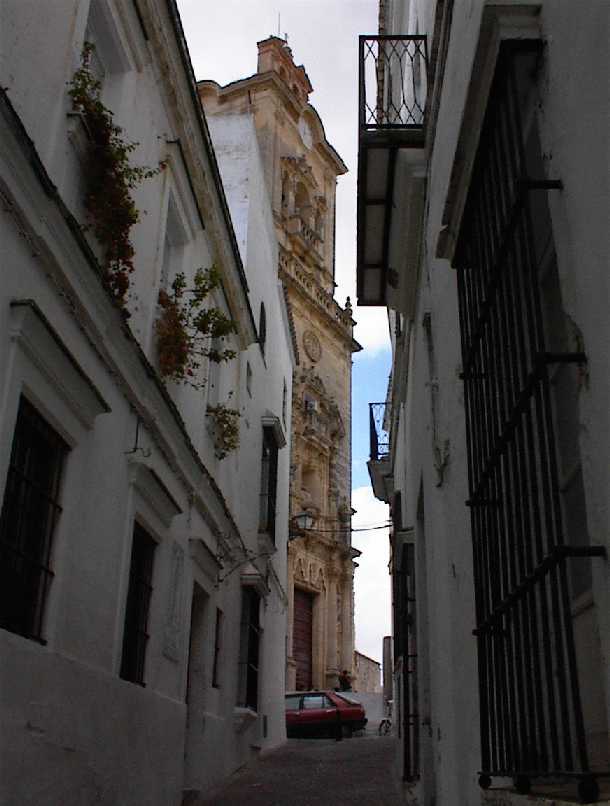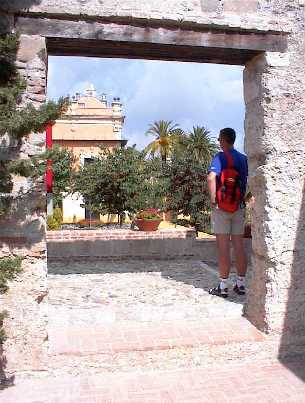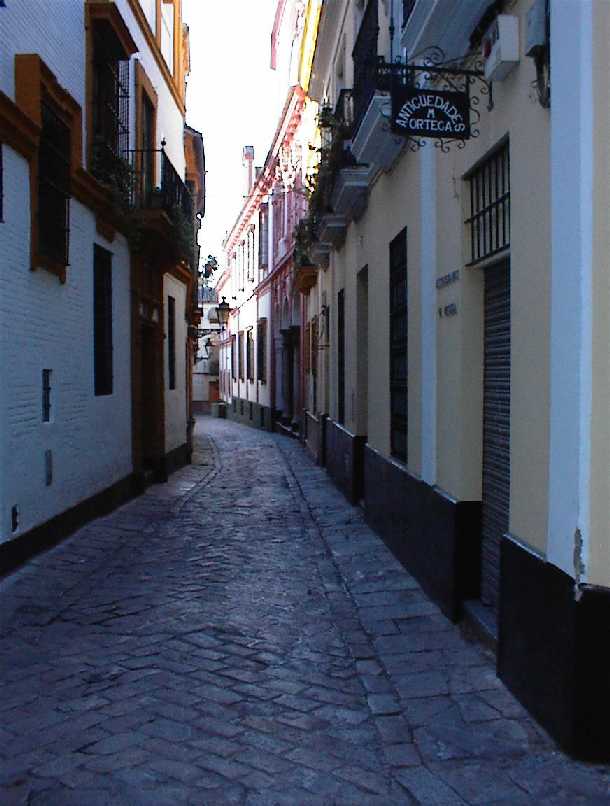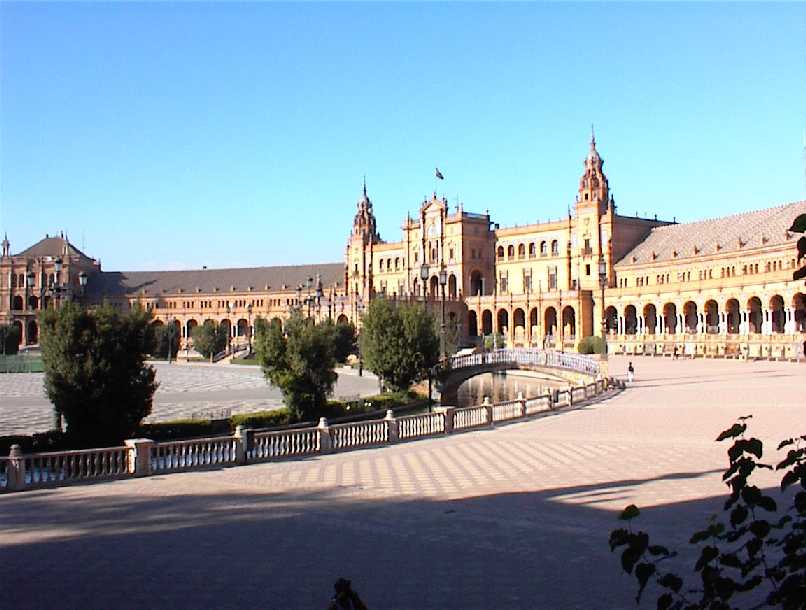Sunday, 5 September 1999
Today we are going on to
Arcos de la Frontera. The old centre of this white washed town is on a hill
top. We take a room in the Parador. The brochure did not exaggerate! The 16th
century mansion is perched on a rock pedestal. We have a room with balcony and a
superb view. Even from the bath tub the view of the surrounding olive groves and
hills is breath taking! We stroll through the town and have lunch in a
de la Frontera. The old centre of this white washed town is on a hill
top. We take a room in the Parador. The brochure did not exaggerate! The 16th
century mansion is perched on a rock pedestal. We have a room with balcony and a
superb view. Even from the bath tub the view of the surrounding olive groves and
hills is breath taking! We stroll through the town and have lunch in a simple restaurant. The waiter tells us that he will be working Rotterdam next
year for six months. Maybe we'll meet him there.
simple restaurant. The waiter tells us that he will be working Rotterdam next
year for six months. Maybe we'll meet him there.
In the evening we have dinner in the Parador. I order Rabo de Toro, or Bull's tail. I can't recommend it. Lots of bone a few meat. We conclude with coffee and Spanish brandy, Lepanto from Jerez.
Monday, 6 September 1999
We head for Jérez de
la Frontera. We first visit the Alcazar. This is the former Moorish
fortress and palace of Jérez. It has been converted many a time after the Moors
left by the C hristian rulers. It also contains a mosque, which has been
carefully restored, after having served as a church for centuries. Also the
gardens are well worth a look, as are the Arab baths at the back of it. The
Alcázar also houses a Camera Obscura. Through a mirror and a lense we're
presented with a marvelous view of town on a round screen. After this we visit
the Bodega of Gonzales Byass, one of the prime sherry producers of Jérez.
Jérez lies at the heart of the Sherry district. The word sherry is an English corruption of the Moorish name for
Jérez, Xeres. English wine merchants
established themselves in Jérez as far back as the 14th century, followed 200
years later by English Catholics, discriminated against back home. Still the
sherry industry is dominated by firms with English roots and/or connections.
Britain and the Netherlands make up for more than 70% of sherry exports. Gonzales
Byass is the producer of Tio Pepe, a fino, or dry sherry. The roof
of the Bodega is adorned with a enourmous weather vane, the biggest in the world
and recognised by the Guinness Book of Records. We are scuttled around
the compound in a stupid tourist train and are shown around the production
facilities that are no longer used. We're told about the different types of
sherry (fino, amontillado, oloroso). Jérez also produces Spanish brandies, akin
to French Cognac. Lepanto is one of the better brands (by Gonzales Byass).
Towards the end of the tour we get a sample of a fino and an oloroso and a
professional sherry taster shows his skills at long distance sherry pouring.
hristian rulers. It also contains a mosque, which has been
carefully restored, after having served as a church for centuries. Also the
gardens are well worth a look, as are the Arab baths at the back of it. The
Alcázar also houses a Camera Obscura. Through a mirror and a lense we're
presented with a marvelous view of town on a round screen. After this we visit
the Bodega of Gonzales Byass, one of the prime sherry producers of Jérez.
Jérez lies at the heart of the Sherry district. The word sherry is an English corruption of the Moorish name for
Jérez, Xeres. English wine merchants
established themselves in Jérez as far back as the 14th century, followed 200
years later by English Catholics, discriminated against back home. Still the
sherry industry is dominated by firms with English roots and/or connections.
Britain and the Netherlands make up for more than 70% of sherry exports. Gonzales
Byass is the producer of Tio Pepe, a fino, or dry sherry. The roof
of the Bodega is adorned with a enourmous weather vane, the biggest in the world
and recognised by the Guinness Book of Records. We are scuttled around
the compound in a stupid tourist train and are shown around the production
facilities that are no longer used. We're told about the different types of
sherry (fino, amontillado, oloroso). Jérez also produces Spanish brandies, akin
to French Cognac. Lepanto is one of the better brands (by Gonzales Byass).
Towards the end of the tour we get a sample of a fino and an oloroso and a
professional sherry taster shows his skills at long distance sherry pouring.
Early evening, back in Arcos, we join a guided tour, organised by the local Tourist Office, discovering the patios of Arcos. The guide shows us a great number of patios, many of which are in residential homes. The owners are very proud to show their patio to visitors. Our group is a small one: four persons. Later at night we have dinner at El Convento. Lovely food. The tomato soup turns out not to be fluid and has to eaten with knife and fork!
Tuesday, 7 September 1999
We reach our hotel Casas de
la Juderïa after some careful navigating of Seville's narrow
inner city streets. It is a lovely hotel smack in the middle of Seville's historical Santa Cruz district. It's housed in 17th
century buildings that used to be guest rooms for a noble family. The rooms are
situated around a number of lovely patios.
in the middle of Seville's historical Santa Cruz district. It's housed in 17th
century buildings that used to be guest rooms for a noble family. The rooms are
situated around a number of lovely patios.
After having taken in our nice accommodation (four poster bed and Jacuzzi!) we get going for the Cathedral. A nice stroll through the Barrio Santa Cruz gets us the world's largest church (by volume). It the one of the main drags of the city and an impressive sight. Especially the main chapel is magnificent. The church was built after the reconquista at the site of the main mosque. The mosque's forecourt, the Patio de Naranjas has been saved. The church also holds the grave of Columbus, or so one believes, as there is great uncertainty surrounding the origins of the bones buried here. I also climb the Giralda, de bell tower. Once it was the mosque's minaret. The way up is a bit uncommon. 35 slopes, wide enough for two soldiers on horseback. The view is magnificent. The city and its surroundings are at my feet.
The afternoon we spend at the Plaza de España
and the Parque de María Louisa. The buildings around the Plaza de España have
been built for the Ibero-American exhibition of 1929, which was a bit of a flop
because of the economic crisis of that year. Around the crescent are tiled
scenes and maps of each of the provinces. The Parque Maria Louise is a nice park ,
where touristy horse drawn carriages come and go. On our way to the Plaza we
passed the Hotel Alfonso XIII, Seville top notch hotel. It was built to house
the V.I.P.'s visiting the 1929 exhibition. It has a beautiful patio. Next to it
is the Tobacco factory. It was that Carmen, a character from Bizet's opera,
worked as a cigar maker. The building was built around 1750 and is the second
largest building in Spain. It is now part of the University. Although it is only
six thirty, it is still extremely hot. The thermometer hovers around 38°
C or 100°F and Seville
proves its reputation as Spain's frying pan.
,
where touristy horse drawn carriages come and go. On our way to the Plaza we
passed the Hotel Alfonso XIII, Seville top notch hotel. It was built to house
the V.I.P.'s visiting the 1929 exhibition. It has a beautiful patio. Next to it
is the Tobacco factory. It was that Carmen, a character from Bizet's opera,
worked as a cigar maker. The building was built around 1750 and is the second
largest building in Spain. It is now part of the University. Although it is only
six thirty, it is still extremely hot. The thermometer hovers around 38°
C or 100°F and Seville
proves its reputation as Spain's frying pan.
At night we move into the, substantial gay scene of Seville. Tonight we stay around Paseo Maritimo and Calle Reyes Catolicos.